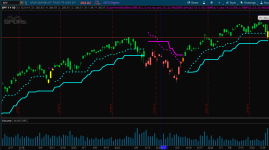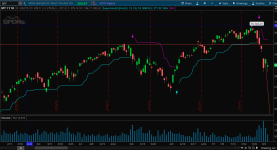Linus has a few really nice supertrend scripts in the ThinkScript_Cloud. Here are 2 I found useful:

Supertrend - #hint: Alternative SuperTrend algorithm.

When you go into the properties, you'll notice how you can change the movingavg type from Simple, Exponential, Wilders, Hull, and Weighted. I'm still trying to figure out which would be best for these.
Contrary to what many think, I actually like using ATR trailing stop-esque indicators for both entry and management of a trade. These both might even work well together if you use one as an entry and the other to manage. I'm thinking this might work very well with AMM (Advanced Market Moves) indicator. Maybe use that as entry, and these as management. We should mix and match to see what is most effective.
Would appreciate your feedback after testing.
Code:
## START STUDY
## SuperCombo Bull/Bear Indicator
## linus, 2014-07-24, v0.1
#hint: SuperTrend of price, RSI and Ultimate Oscillator, combined with Chandelier stops.
## Signal inputs:
input paintBars = {OFF, default DIR, STR};
input signals = {OFF, default ALL, ST, CS, RSI, UO};
input strength = {"1", "2", default "3", "4"};
input showLabel = Yes;
input showBubbles = Yes;
input showPrompt = Yes;
## SuperTrend of Price inputs:
input stATRMult = 3.5;
input stATRLength = 22;
input stATRType = AverageType.WILDERS;
input stPivot = hl2;
## Chandelier Stop inputs:
input csPeriod = 15;
input csATRLength = 5;
input csATRMult = 3.0;
input csATRType = AverageType.SIMPLE;
input csShift = 1;
input csHideOpposite = Yes;
## SuperTrend of RSI inputs:
input rsiLength = 14;
input rsiPrice = close;
input rsiSmooth = 2;
input rsiSmoothType = AverageType.SIMPLE;
input rsiATRMult = 2.3;
input rsiATRLength = 25;
input rsiATRType = AverageType.WILDERS;
## SuperTrend of Ultimate Oscillator inputs:
input uoFastLen = 7;
input uoMedLen = 14;
input uoSlowLen = 28;
input uoATRMult = 2.8;
input uoATRLength = 3;
input uoATRType = AverageType.SIMPLE;
########################################
## SuperTrend of Price
def stATR = MovingAverage(stATRType, TrueRange(high, close, low), stATRLength) * stATRMult;
def stUp = stPivot + stATR;
def stDn = stPivot - stATR;
def rStTrend = compoundValue(1,
if rStTrend[1] > 0 then
if close < Max(stDn[1], rStTrend[1]) then -stUp
else Max(stDn, rStTrend[1])
else if rStTrend[1] < 0 then
if close > Min(stUp[1], AbsValue(rStTrend[1])) then stDn
else -Min(stUp, AbsValue(rStTrend[1]))
else rStTrend[1]
, stPivot);
plot StTrend = if Sign(rStTrend) == Sign(rStTrend[1]) then absValue(rStTrend) else Double.NaN;
StTrend.DefineColor("Up", Color.CYAN);
StTrend.DefineColor("Dn", Color.MAGENTA);
StTrend.AssignValueColor(if rStTrend > 0 then StTrend.Color("Up") else StTrend.Color("Dn"));
StTrend.HideBubble();
StTrend.SetLineWeight(3);
########################################
## Chandelier_Stops
def csATR = MovingAverage(csATRType, TrueRange(high, close, low), csATRLength) * csATRMult;
def smax = Lowest(low, csPeriod)[csShift] + csATR[csShift];
def smin = Highest(high, csPeriod)[csShift] - csATR[csShift];
def rCSTrend = compoundValue(1, if close > smax[1] then 1 else if close < smin[1] then -1 else rCSTrend[1], 0);
def rUB = compoundValue(1, if rCSTrend > 0 then if smax > rUB[1] then smax else rUB[1] else if rCSTrend < 0 then if smax < rUB[1] then smax else rUB[1] else rUB[1], high);
def rLB = compoundValue(1, if rCSTrend < 0 then if smin < rLB[1] then smin else rLB[1] else if rCSTrend > 0 then if smin > rLB[1] then smin else rLB[1] else rLB[1], low);
plot UB = if !csHideOpposite or rCSTrend < 0 then rUB else Double.NaN;
UB.SetDefaultColor(Color.MAGENTA);
UB.SetLineWeight(3);
UB.SetStyle(Curve.SHORT_DASH);
UB.HideBubble();
plot LB = if !csHideOpposite or rCSTrend > 0 then rLB else Double.NaN;
LB.SetDefaultColor(Color.CYAN);
LB.SetLineWeight(3);
LB.SetStyle(Curve.SHORT_DASH);
LB.HideBubble();
########################################
## SuperTrend of RSI
def avgDif = WildersAverage(AbsValue(rsiPrice - rsiPrice[1]), rsiLength);
def RSI = MovingAverage(rsiSmoothType, 50 * ((if avgDif != 0 then WildersAverage(rsiPrice - rsiPrice[1], rsiLength) / avgDif else 0) + 1), rsiSmooth);
def rsiATR = MovingAverage(rsiATRType, TrueRange(Highest(RSI, ceil(rsiATRMult)), RSI, Lowest(RSI, ceil(rsiATRMult))), rsiATRLength) * rsiATRMult;
def rsiUp = RSI + rsiATR;
def rsiDn = RSI - rsiATR;
def rRSITrend = compoundValue(1,
if rRSITrend[1] > 0 then
if RSI < Max(rsiDn[1], rRSITrend[1]) then -rsiUp
else Max(rsiDn, rRSITrend[1])
else if rRSITrend[1] < 0 then
if RSI > Min(rsiUp[1], AbsValue(rRSITrend[1])) then rsiDn
else -Min(rsiUp, AbsValue(rRSITrend[1]))
else rRSITrend[1]
, RSI);
########################################
## SuperTrend of Ultimate Oscillator
def TR = TrueRange(high, close, low);
def BP = close - Min(close[1], low);
def nFast = (uoSlowLen / uoFastLen);
def nMed = (uoSlowLen / uoMedLen);
def trFast = sum(TR, uoFastLen);
def trMed = sum(TR, uoMedLen);
def trSlow = sum(TR, uoSlowLen);
def UO = 100 * (((if trFast != 0 then (sum(BP, uoFastLen) / trFast) * nFast else 0)
+ (if trMed != 0 then (sum(BP, uoMedLen) / trMed) * nMed else 0)
+ (if trSlow != 0 then (sum(BP, uoSlowLen) / sum(TR, uoSlowLen)) else 0))
/ (nFast + nMed + 1));
def uoATR = MovingAverage(uoATRType, TrueRange(Highest(UO, ceil(uoATRMult)), UO, Lowest(UO, ceil(uoATRMult))), uoATRLength) * uoATRMult;
def uoUp = UO + uoATR;
def uoDn = UO - uoATR;
def rUOTrend = compoundValue(1,
if rUOTrend[1] > 0 then
if UO < Max(uoDn[1], rUOTrend[1]) then -uoUp
else Max(uoDn, rUOTrend[1])
else if rUOTrend[1] < 0 then
if UO > Min(uoUp[1], AbsValue(rUOTrend[1])) then uoDn
else -Min(uoUp, AbsValue(rUOTrend[1]))
else rUOTrend[1]
, UO);
########################################
## Signals
def orderDir;
def p;
def sumUp = (rStTrend > 0) + (rCSTrend > 0) + (rRSITrend > 0) + (rUOTrend > 0);
def sumDn = (rStTrend < 0) + (rCSTrend < 0) + (rRSITrend < 0) + (rUOTrend < 0);
switch (signals) {
case OFF:
orderDir = 0;
p = 0;
case ALL:
orderDir = compoundValue(1, if sumUp >= strength+1 then 1 else if sumDn >= strength+1 then -1 else orderDir[1], 0);
p = if showPrompt then 1 else 0;
case ST:
orderDir = rStTrend;
p = if showPrompt then 2 else 0;
case CS:
orderDir = rCSTrend;
p = if showPrompt then 3 else 0;
case RSI:
orderDir = rRSITrend;
p = if showPrompt then 4 else 0;
case UO:
orderDir = rUOTrend;
p = if showPrompt then 5 else 0;
}
def isOrder = orderDir crosses 0;
def orderCount = compoundValue(1, if isNaN(isOrder) then 0 else if isOrder then orderCount[1] + 1 else orderCount[1], 0);
def noBar = isNaN(open[-1]);
def orderPrice = if isOrder then if noBar then close else open[-1] else orderPrice[1];
def profitLoss = if !isOrder or orderCount == 1 then 0 else if orderDir > 0 then orderPrice[1] - orderPrice else if orderDir < 0 then orderPrice - orderPrice[1] else 0;
def profitLossSum = compoundValue(1, if isNaN(isOrder) then 0 else if isOrder then profitLossSum[1] + profitLoss else profitLossSum[1], 0);
AddLabel(signals and showLabel, (if p==1 then "ALL: " else if p==2 then "ST: " else if p==3 then "CS: " else if p==4 then "RSI: " else if p==5 then "UO: " else "") + orderCount + " orders | P/L " + AsDollars((profitLossSum / tickSize()) * tickValue()), if profitLossSum > 0 then Color.GREEN else if profitLossSum < 0 then Color.RED else Color.GRAY);
AddChartBubble(signals and showBubbles and isOrder and orderDir > 0, low, profitLoss, if noBar then Color.LIGHT_GRAY else Color.GREEN, 0);
AddChartBubble(signals and showBubbles and isOrder and orderDir < 0, high, profitLoss, if noBar then Color.GRAY else Color.RED, 1);
AssignPriceColor(if !paintBars then Color.CURRENT
else if paintBars == paintBars.DIR then
if orderDir > 0 then
if rSTTrend < 0 or rCSTrend < 0 then Color.DARK_ORANGE
else Color.UPTICK
else if orderDir < 0 then
if rSTTrend > 0 or rCSTrend > 0 then Color.YELLOW
else Color.DOWNTICK
else Color.GRAY
else if sumUp >= strength+1 then Color.UPTICK
else if sumDn >= strength+1 then Color.DOWNTICK
else if sumUp > sumDn then Color.YELLOW
else if sumDn > sumUp then Color.DARK_ORANGE
else Color.GRAY);
## END STUDYSupertrend - #hint: Alternative SuperTrend algorithm.
When you go into the properties, you'll notice how you can change the movingavg type from Simple, Exponential, Wilders, Hull, and Weighted. I'm still trying to figure out which would be best for these.
Contrary to what many think, I actually like using ATR trailing stop-esque indicators for both entry and management of a trade. These both might even work well together if you use one as an entry and the other to manage. I'm thinking this might work very well with AMM (Advanced Market Moves) indicator. Maybe use that as entry, and these as management. We should mix and match to see what is most effective.
Would appreciate your feedback after testing.
Attachments
Last edited by a moderator:


